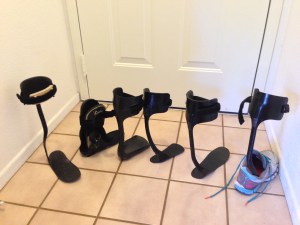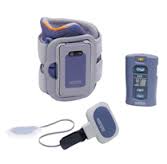Brace Yourself for MS


One of the MS blogs that I follow is written by Jen, who lives in England. It’s called Tripping Through Treacle. Doesn’t that neatly sum up the lives of many of us in just three alliterative words? From MS newbies to old-timers like me, we worry (or have worried) about tripping. Many of us try to do something about that, however, and one of the options is to wear a brace.
AFOs
The formal name for these uncomfortable looking things is Ankle-Foot Orthosis, or AFO. Jamie, who writes the Multiple Experiences blog, is trying an AFO right now to help with her foot drop, which is what trips up many of us. Well, she’s sort of using one. Jamie has told her blog followers that she “hates” the brace. She finds it inconvenient to use, especially because you need to take off your shoe, slip the AFO into that shoe, strap it onto your shin, and put your shoe back on when you want to walk with it. This can be particularly cumbersome if you need it on your right leg, the leg that you use when you’re driving. Jamie says she’d rather use her walker, but she plans to give the AFO another try in a couple of weeks with help from a physical therapist.
Working with a PT or, better yet, an orthotist is important. An orthotist is a specialist in making and fitting orthosis. After getting a prescription, the orthotist will measure your leg and foot, and the AFO is then custom-made from those measurements. Then the orthotist fits, tests, and adjusts it before sending you back out into the world to walk with it.

Cheryl’s AFO collection
An AFO is typically made from metal or plastic, but some are made of strong, but lightweight, carbon fiber. Cheryl Hile, an MS patient who runs marathons and about whom I wrote several weeks ago, has half a dozen custom-made AFOs to use in various situations. I used an AFO a few years ago for a short period of time (though I wasn’t running any marathons), until I “upgraded” to a Bioness L300 device.
FES Units
The Bioness L300 uses a cuff that straps to your leg under the knee cap. A pad in the heal of your shoe senses when you begin to try to raise your foot. It then sends a programmed,  low-level electrical stimulation that activate the nerves and muscles that raise your toes and lift the foot. (The process is known as Functional Electrical Stimulation, or FES). You’ll need a prescription for the L300 and a Bioness-approved therapist will need to fit you and adjust the unit.
low-level electrical stimulation that activate the nerves and muscles that raise your toes and lift the foot. (The process is known as Functional Electrical Stimulation, or FES). You’ll need a prescription for the L300 and a Bioness-approved therapist will need to fit you and adjust the unit.
I’ve used an L300 for about five years. At first, it worked so well that I was able to walk a city block without tiring, something that I hadn’t been able to do previously. With my cane I even walked up a grass-covered hill, which was amazing. Alas, I don’t walk as well, overall, as I did five years ago and I’m now using two canes. I can’t do that hill anymore, but without the Bioness strapped to my leg I wouldn’t be able to walk more than about 50 feet. I really depend upon it. The L300 can also be put into a “test” mode, which will trigger the stimulus while you’re sitting in a chair, so that you can exercise that leg muscle even when you’re not walking.
A similar unit is made by WalkAide. Unlike the Bioness unit’s sensor, the WalkAide cuff, itself, senses your movement, so you don’t have to wear a shoe. I tried a WalkAide, briefly, when I was trying the L300 but I didn’t feel as stable with it as I did with the Bioness unit. Remember, both with AFOs and these FES units, each MS patient is probably going to have a different user experience. I’d recommend taking each device for a test walk, or two, before you buy.
Naturally, none of these devices are inexpensive. I think my custom-made carbon AFO cost about $800, which included the services of the orthotist. The L300 was selling for about $5,000 five or six years ago, but I was able to get a slightly used one for around $3,000. Insurance covered most of the cost of my AFO, but it didn’t cover any of my FES. (That’s a rant for a future column).
If you’d like more information about all kinds of mobility devices, checkout the (U.S.) National MS Society’s website.
I’d like to hear about experiences you’ve had with AFOs and FES units.
(You can see some of my other columns on my personal page: www.themswire.com).
Note: Multiple Sclerosis News Today is strictly a news and information website about the disease. It does not provide medical advice, diagnosis, or treatment. This content is not intended to be a substitute for professional medical advice, diagnosis, or treatment. Always seek the advice of your physician or other qualified health provider with any questions you may have regarding a medical condition. Never disregard professional medical advice or delay in seeking it because of something you have read on this website. The opinions expressed in this column are not those of Multiple Sclerosis News Today, or its parent company, Bionews Services, and are intended to spark discussion about issues pertaining to multiple sclerosis.







Matt Blum
The Bioness has a weak side. Prolonged use (you like I used it for 5 years) tends to burn a hole (unknown) into your foot side. When it burns you through, all bets are off. BE CAREFUL. Our VA provided it to me, 6 years ago. I now never use it and have a weak and sometimes stumble on my left leg. So goes my MS.
Ed Tobias
Hi Matt,
Thanks for mentioning this. I'd never heard of this problem. Can you tell us all a little more? Are you talking about your leg, where the electrodes are placed, or do you really mean your foot? How did you discover this hole?
Ed
Jocelyn Mustain
I have used my Bioness for over 5 years now: like you, it originally helped me walk straight & helps now that I cannot walk as far. I don't know about burning a hole...will try looking that up
Ed Tobias
Hi Jocelyn,
Thanks for your comment. Please let us all know if your research turns up anything.
Ed
Judy Lynn
Thanks for this article, Ed. It took me many months to figure out that I COULD drive with the AFO on my right leg if I just unhooked the velcro strap!! None of my docs ever suggested it, even when I said I didn't wear it because I couldn't drive in it. Now I have hand controls and don't need it as often. My foot drop sort of comes and goes. I'll be honest, I am both intrigued and afraid to try the FES- does it hurt when it electrocutes, lol...I mean signals your foot to lift?
Does FES hurt? You certainly feel it but the concept of pain varies from person to person. I tried FES but found but did hurt me.
Judy Lynn
Thanks, Ed and Ian. I have heard that I could give it a trial run before purchase, so I think it would be worth a try in the future. Great tips, Ed.
Ed Tobias
My PT wrote an Rx for a Bioness L300 evaluation. I took that to a PT near my home who adjusted it for me and worked with me over three or four sessions to see if it was worth the investment.
Ed
Ed Tobias
When the Bioness triggers I feel a buzz travel down the nerve in my left leg from the electrode, which is a couple of inches below my knee, to my foot. If the cuff with the electrodes is placed correctly, (and that's very important), the sensation shouldn't be painful. If you wear the cuff for several hours the electrodes can become dry. Then, the stimulation can be painful.
Bioness suggested that I not wear the cuff for more than four hours before taking it off for a short period. I damped the electrodes before putting it back on. There's also an option to use a cloth application with the electrodes embedded. I found that this lessened the sensation but wasn't as effective as the jell electrodes.
You can find more info on www.bioness.com.
Ed
Judy Lynn
I just checked out the Multiple Experiences blog. Couldn't find a way to comment there :-( but I did notice that her picture of a brace looks different than mine. Undoing the velcro may not work for all types of AFOs.
kathleen regan
I've had foot drop from minute one, with diagnosis made in 2006 until now, December 2017. In 2013, VA approved me for the Walkaide. I was fitted by VA staff PT and the company rep. I wear it every day, sometimes for more than 8 hours, without issue. I feel strange if I skip a day, and to catch up it seems I never fully can do so without pain or low function adaptability. The walkaide has saved me many risks for falls or stumbling. IMO, once you learn the correct placement and frequency levels, this device is the best way to try for muscle memory and help in keeping active and mobile. I will use it without any embarrassment or apology. I even wear it with shorts and skinny jeans! If it works for you, stay with it. It takes a little time and some motivation to explore options. When MS tries to call the score, I refuse to give up or give in. Just my opinion. Flapkatt916